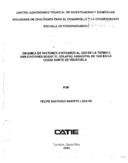| dc.contributor.advisor | Páez, Gilberto | es_ES |
| dc.contributor.author | Baritto Lozano, F.S. | |
| dc.date.accessioned | 2020-12-09T21:27:48Z | |
| dc.date.available | 2020-12-09T21:27:48Z | |
| dc.date.issued | 2000 | |
| dc.identifier.uri | https://repositorio.catie.ac.cr/handle/11554/10114 | |
| dc.description | Tesis (Mag. Sc.)--CATIE, Turrialba (Costa Rica), 2000 | es_ES |
| dc.description | 104 páginas | |
| dc.description | 21 fig. 30 tab | |
| dc.description | Referencias 99-103 | |
| dc.description.abstract | A mediados de diciembre de 1999 la población venezolana fue seriamente afectada por uno de los peores desastres naturales ocurridos en su historia, concentrándose con mayor severidad en la región norte del país y más específicamente en las áreas correspondientes al Estado Vargas en la Cordillera de La Costa por la incidencia de precipitaciones de intensidad y duración extremas que provocaron aludes torrenciales e inundaciones de gran magnitud, dejando como resultado cuantiosas pérdidas económicas y de vidas humanas, y un daño importante a los ecosistemas. En la presente investigación se analizaron tres aspectos básicos relacionados con esta problemática. En primer lugar, se estudió el proceso de ocupación e intervención del espacio previo al evento de 1999, usando como referencia información espacio-temporal contenida en una serie de fotografías aéreas de los años 1958, 1973, 1983 y 1994, e información temática diversa, y la relación de las trnasiciones en el uso de la tierra expresada en el paisaje con factores directrices que contribuyen a facilitar o restringir la ocurrencia de cambios, usando modelos multinomiales logísticos. De esta manera, la probabilidad de transición de usos de la tierra enn el tiempo fue utilizada como un indicador del proceso de evolución hacia una mayor exposición de la población a condiciones riesgosas y de la intervención del ecosistema. En segundo lugar, se analizó la respuesta de áreas a la incidencia del evento de 1999 utilizando información del satélite IKONOS-2 y relacionando las diferentes categorías de daños identificadas en el espacio con factores físicos (relieve, geología, distancia a cursos de agua) y el uso previo de la tierra. Por último, se analizó la periodicidad de eventos extremos de precipitación, tomando como referencia los valores máximos diarios registrados en dos estaciones meteorológicas localizadas en la parte baja de la Cordillera de La Costa (Mano y Maiquetía), y una estación ubicada en la parte alta (Caracaya), por medio de análisis armónico de series finitas de Fourier. | es_ES |
| dc.description.abstract | About the middle of December 1999, the Venezuelan population was seriously affected by one of the worse natural disasters that occurred in its history. The disaster occurred with greater severity in the northern region of the country, more specifically in areas of Vargas State in the La Costa Mountain Chain because the incidence of high-intensity and long duration rains that provoked torrential landslides and flooding of great magnitude. The resulting damage was substantial human and economic losses, as well as important damage to the ecosystem. In the present study, three basic aspects related to this problem were analyzed. In the first place, the process of spatial occupation and interention previous to the 1999 event was studied, using time-spatial information contained in a series of aerial photographs of 1958, 1973, 1983 and 1994, information of diverse themes, and the relation of the transitions in the land use expressed in the landscape with factors that contribute to promote or restrict these changes, by using multinomial logit models. In this manner, the probability of transition of land use through time was utilized as an indicator of the process of evolution towards a greater exposure of the population to risky conditions and ecosystem intervention. In the second place, the response of the area to the event of 1999 was analyzed using information from IKONO-2 satellite, and relating the different categories of spatial damages identified with physical factors (relief, lithologic units, distance to the water course) and prior land use. Finally, the periodicity of the extreme precipitation events was analyzed by means of harmonic analysis of Fourier finite series. The basic information used were the maximum daily values registered per year in two meteorological stations located in the lower part of the La Costa Mountain Chain (Mamo and Maiquetía), and a station located in the upper part (Caracaya). | |
| dc.language.iso | es | es_ES |
| dc.publisher | CATIE, Turrialba (Costa Rica) | es_ES |
| dc.subject | DESASTRES | |
| dc.subject | IMPACTO AMBIENTAL | |
| dc.subject | PRECIPITACION ATMOSFERICA | |
| dc.subject | UTILIZACION DE LA TIERRA | |
| dc.subject | VENEZUELA | |
| dc.subject | DISASTERS | |
| dc.subject | PRECIPITATION | |
| dc.title | Dinámica de factores asociados al uso de la tierra e implicaciones sobre el colapso ambiental de 1999 en la costa norte de Venezuela | es_ES |
| dc.type | Tesis | es_ES |


